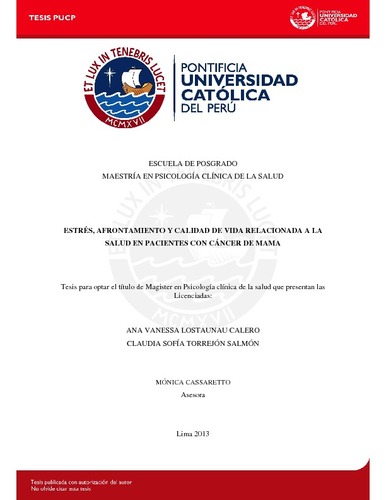| dc.contributor.advisor | Cassaretto Bardales, Mónica de los Milagros | es_ES |
| dc.contributor.author | Lostaunau Calero, Ana Vanessa | es_ES |
| dc.contributor.author | Torrejón Salmón, Claudia Sofía | es_ES |
| dc.date.accessioned | 2014-03-25T15:17:20Z | es_ES |
| dc.date.available | 2014-03-25T15:17:20Z | es_ES |
| dc.date.created | 2013 | es_ES |
| dc.date.issued | 2014-03-25 | es_ES |
| dc.identifier.uri | http://hdl.handle.net/20.500.12404/5175 | |
| dc.description.abstract | El cáncer de mama puede ser considerado un evento de vida potencialmente estresante pues demanda cambios que tienden a exceder la capacidad de las pacientes para afrontar dicha condición,
lo que afecta negativamente su CVRS. Este estudio examina la contribución que tienen el estrés percibido, el estrés traumático, los estilos de afrontamiento, la migración y el tipo de tratamiento recibido sobre la variabilidad de los componentes físico y mental de la CVRS de 53 mujeres mastectomizadas, que han sido diagnosticadas por primera vez con cáncer de mama. Los instrumentos utilizados comprendieron la adaptación española del cuestionario de salud (SF-36)
(Alonso, Prieto & Antó, 1995), el inventario de estimación de afrontamiento COPE (Carver, Scheier & Weintraub, 1989), la escala de estrés percibido EEP (Cohen, Kamarck & Mermelstein, 1983) y la adaptación peruana de la escala de estrés traumático (Gargurevich, 2006).
Se encontraron niveles promedio y altos de la CVRS. El componente físico se vio más
afectado que el componente mental, especialmente en las pacientes migrantes. En el componente físico, se obtuvo un modelo conformado por la migración, el tipo de tratamiento y el estrés traumático, quienes explicaron el 30% de su variabilidad. En tanto, en el componente mental se obtuvieron dos modelos; el primero conformado por el estrés traumático y el estrés percibido, quienes explicaron el 39% de su variabilidad; mientras que el segundo, conformado por el estrés
traumático, estrés percibido y el estilo orientado a la emoción explicaron el 42% de su variabilidad.
Palabras clave: Calidad de vida relacionada a la salud (CVRS), afrontamiento, estrés percibido,estrés traumático, cáncer de mama, migración y tipo de tratamiento. | es_ES |
| dc.description.abstract | Breast cancer might be considered a life-threatening event as it demands changes that could exceed the patient’s abilities to cope with their illness, therefore, affect HRQoL in a negative way.
This study analyzes the contribution that traumatic stress, perceived stress, coping, migration and type of treatment have on the variability of physical and metal components of the HRQoL of 53
mastectomized women with breast cancer. The instruments used include the Spanish adaptation of the SF-36 health survey (Alonso, Prieto & Antó, 1995), the COPE Inventory (Carver, Scheier & Weintraub, 1989), the Perceived Stress Scale PSS (Cohen, Kamarck & Mermelstein, 1983) and the Peruvian adaptation of the traumatic stress scale (Gargurevich, 2006).
The analysis found medium and high levels of the HRQoL. Physical component was more
affected than mental component, especially in migrant patients. The model of the physical component was comprised by migration, treatment type and traumatic stress, which explained 30% of its variability. On the other hand, two models were obtained from the mental component; the first was comprised by traumatic stress and perceived stress, which explained 39% of its variability, while the second model, comprised by traumatic stress, perceived stress an emotion-oriented stress, explained 42% of its variability | es_ES |
| dc.description.uri | Tesis | es_ES |
| dc.language.iso | spa | es_ES |
| dc.publisher | Pontificia Universidad Católica del Perú | es_ES |
| dc.rights | info:eu-repo/semantics/openAccess | es_ES |
| dc.rights.uri | http://creativecommons.org/licenses/by-nc-sa/2.5/pe/ | * |
| dc.subject | Stress (Psicología) | es_ES |
| dc.subject | Adaptación (Psicología) | es_ES |
| dc.subject | Calidad de vida. | es_ES |
| dc.subject | Mamas--Cáncer--Aspectos psicológicos. | es_ES |
| dc.title | Estrés, afrontamiento y calidad de vida relacionada a la salud en pacientes con cáncer de mama. | es_ES |
| dc.type | info:eu-repo/semantics/masterThesis | es_ES |
| thesis.degree.name | Maestro en Psicología Clínica de la Salud | es_ES |
| thesis.degree.level | Maestría | es_ES |
| thesis.degree.grantor | Pontificia Universidad Católica del Perú. Escuela de Posgrado | es_ES |
| thesis.degree.discipline | Psicología Clínica de la Salud | es_ES |
| renati.advisor.dni | 09491245 | |
| renati.advisor.orcid | https://orcid.org/0000-0002-4880-6092 | es_ES |
| renati.discipline | 313247 | es_ES |
| renati.level | https://purl.org/pe-repo/renati/level#maestro | es_ES |
| renati.type | http://purl.org/pe-repo/renati/type#tesis | es_ES |
| dc.publisher.country | PE | es_ES |
| dc.subject.ocde | https://purl.org/pe-repo/ocde/ford#5.01.00 | es_ES |






